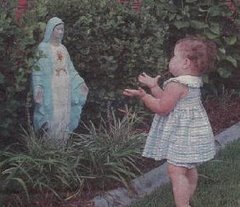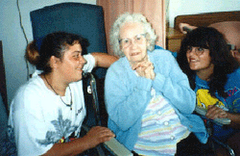- Tuition at the Catholic grade school was $1 per month, with a lower cost for families with 3 or more children. One family in our school had 18 children.
- Only sisters in full habit taught in the school, and most seemed quite young.
- The sisters lived in a convent house owned by the parish and they cooked their own meals, often with food donated by parishioners. Finally, they needed another house because so many nuns came, and they rented one across the street. One or two nuns had to crawl up the ladder and sleep on mattresses in the attic because no other sleeping space was available.
- The sisters had no car and they did not drive, so they relied on a volunteer woman driver (one of my aunts) to take two of them to the grocery store and the department store once a week. I got to go along at least once and it was lots of fun being with the sisters in the crowded car.
- A lot of the sisters were good artists in that they painted holy cards, signs for the classroom with wonderful script, and made decorations with Easter palms. [Later, I once borrowed some of their handmade script patterns to make pro-life signs.]
- We girls were especially interested in whether the nuns had blonde, brown, or black hair. Only rarely did a wisp of hair peeking out from under her headpiece reveal the actual color. One day we were astonished to learn that our teacher had a sunburn on her arms because she rolled up her sleeves to to wash her clothes.
- Handwriting was a very important skill to practice and learn.
- The English textbooks with stories and associated artwork had already chan
ged from the Misericordia readers series by the Sisters of Mercy to English readers that were not nearly as good. [Perhaps the influence of John Dewey and his friends.]
- Occasionally, we were allowed to buy candy and gum during school from a Sister who made money for the nuns by selling a candy bar or a pack of gum for 5 cents each.
- We had three recesses each day, 15-min ones during the morning and afternoons and an hour-long recess at noon. We ate our lunch rapidly so we could go outside and play. Softball, tag, volleyball, and other games were typically non-structured.
- School started only after Labor Day and we were finished by about May 20.
- Organ music was played in church--only from the balcony to the rear.
- The kneelers in church had no padding and we knelt on wood. Our church, like almost all, had no air conditioning during the summer, so early Sunday Masses at 6:00 am or 8:00 a.m. were best. No microphone either, the priest was expected to preach loud enough to hear.
- On First Fridays, the mothers fixed us hot chocolate and doughnuts after Mass. That morning, the school water faucets were covered with brown paper bags because we were not allowed to drink water after midnight if we wanted to receive communion.
- Father X always passed out the report cards--looking carefully at each one and making us very nervous because he saw our grades first.
- The Baltimore Catechism and a small gray Bible history were our religion textbooks. And we memorized the answers.
- We students especially looked forward to the color comic book that came once a month, Treasure Chest.
- I was confronted during a visit to the Blessed Sacrament during recess by the pastor who asked why I wasn't wearing something on my head. I responded it was recess and the visit was unplanned. I remember asking the priest whether it was better not to make a visit if I didn't have a head covering. He responded by leaving me to pray alone in the silent church.
- I knew only one child of divorced parents during my entire time in grade school.
Apr 6, 2007
Catholic Schooldays--1950
What was Catholic gradeschool like back in the late 40's and early 50's? Here are some memories.
Apr 1, 2007
Complaining About a Complaint Free World
I've been noticing signs advertising the "complaint free world," a program developed by Christ Church Unity in Kansas City that believes in "celebrate[ing] the divinity and God's diversity in all." The minister says he initiated the program because people whined about his choice of worship music. He then asked people to stop complaining and criticizing for three weeks, using purple rubber bracelets that are switched to alternate wrists every time a person complains.
What's right with complaining? When is it a virtue? A person forcefully COMPLAINING about injustice seems to reflect the beatitude, "Blessed are they that hunger and thirst after justice: for they shall have their fill." Frankly, unless my neighbors had not loudly complained about a 2+ year old problem in our neighborhood, the city would never have fixed it.
Jesus' parable about the complaining widow reflects the occasional necessity of complaining to a superior who can make things right:
What's right with complaining? When is it a virtue? A person forcefully COMPLAINING about injustice seems to reflect the beatitude, "Blessed are they that hunger and thirst after justice: for they shall have their fill." Frankly, unless my neighbors had not loudly complained about a 2+ year old problem in our neighborhood, the city would never have fixed it.
Jesus' parable about the complaining widow reflects the occasional necessity of complaining to a superior who can make things right:
Luke 18:1 And he spoke also a parable to them, that we ought always to pray, and not to faint, 2 Saying: There was a judge in a certain city, who feared not God, nor regarded man. 3 And there was a certain widow in that city, and she came to him, saying: Avenge me of my adversary. 4 And he would not for a long time. But afterwards he said within himself: Although I fear not God, nor regard man, 5 Yet because this widow is troublesome to me, I will avenge her, lest continually coming she weary me.Complaining about little things distracts from real problems, but not complaining when vital things are clearly wrong is a vice. A good Christian cannot ignore evil. If he ignores evil, he is compliant with evil. When no one complains about abortion, or an unjust war, or divorce, or any of a host of evil situations, then I know the people have lost their soul. If nothing is worth complaining about, then nothing is worth fighting for, and people have lost their capacity for righteous indignation.
St. Lawrence Center at KU
A Catholic friend is very enthusiastic about the St. Lawrence Catholic Campus Center at the University of Kansas. She described the recent surge in the numbers of potential vocations to the religious life, stating that the increase is approximately 400 percent over the past five years--from about 15 students to about 60 who are considering a religious vocation. I don't know if the numbers are valid, but if so the figures likely represent a real revival for the Catholic Church among young adults.
Subscribe to:
Posts (Atom)








